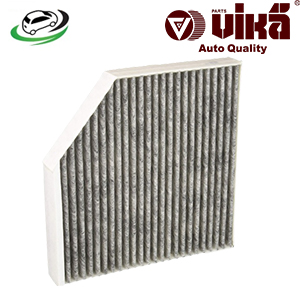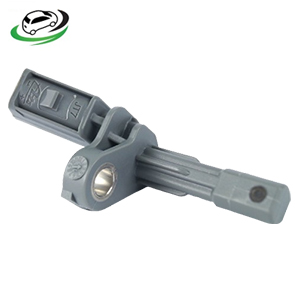-6%
Get Rear Right ABS Wheel Speed Sensor Audi Q3 / VW Beetle Cabrio/Beetle/Eos/Golf Cabriolet/Passat / Variant/CC/Scirocco 1K0927808A
The wheel speed sensor is a critical component in modern vehicles, playing a vital role in various safety and performance systems. It is a small, yet essential sensor that helps monitor the rotational speed of each wheel, providing crucial data to the vehicle’s electronic control units (ECUs). This information is used for functions like anti-lock braking systems (ABS), traction control, and electronic stability control (ESC). In this explanation, we’ll delve into what a wheel speed sensor is, how it works, its importance, common issues, and maintenance tips.
What is a Wheel Speed Sensor?
A wheel speed sensor, often referred to as an ABS sensor, is a small electronic device mounted on each wheel of a vehicle. It is designed to measure the speed at which each wheel is rotating and send this information to the vehicle’s ECUs. There are generally two types of wheel speed sensors: passive (magnetic) sensors and active (Hall-effect) sensors.
- Passive Wheel Speed Sensors: These sensors generate an alternating current (AC) signal as the wheel turns. They rely on a toothed ring (often called a tone ring or reluctor) attached to the wheel or axle. As the teeth of the tone ring pass by the sensor, they induce a magnetic field that generates the AC signal, which corresponds to the wheel’s rotational speed.
- Active Wheel Speed Sensors: These sensors use a more sophisticated technology, typically involving a Hall-effect sensor or magneto-resistive element. Active sensors can generate a signal at very low speeds and provide more accurate data, even when the vehicle is stationary. They also require an external power source, unlike passive sensors.
How Does a Wheel Speed Sensor Work?
The wheel speed sensor works by detecting the rotational speed of the wheel and converting it into an electrical signal that is sent to the vehicle’s ECUs. Here’s a step-by-step breakdown of the process:
- Sensing Rotational Speed: As the wheel rotates, the tone ring or reluctor passes by the sensor. In passive sensors, the teeth of the tone ring cause changes in the magnetic field, generating an AC signal. In active sensors, the sensor detects changes in the magnetic field or the resistance of the material as the wheel turns.
- Signal Generation: The sensor produces a voltage signal that corresponds to the rotational speed of the wheel. The frequency and amplitude of this signal are directly related to how fast the wheel is spinning.
- Signal Transmission: The generated signal is transmitted to the vehicle’s ECUs, where it is processed and used in various systems. For example, in an ABS system, the ECU monitors the wheel speed data to detect if any wheel is locking up during braking.
- Control System Response: Based on the data from the wheel speed sensors, the ECUs can make real-time adjustments to the braking system, traction control, and stability control systems. For example, if the ABS detects a wheel is locking up, it will modulate the brake pressure to that wheel to prevent a skid.
Importance of the Wheel Speed Sensor
The wheel speed sensor is a crucial component for several vehicle systems, contributing to safety, performance, and efficiency:
- Anti-Lock Braking System (ABS): The primary function of the wheel speed sensor is to provide data to the ABS. By monitoring the speed of each wheel, the ABS can prevent the wheels from locking up during hard braking, maintaining steering control and reducing stopping distances.
- Traction Control System (TCS): The wheel speed sensor helps the traction control system by detecting wheel spin during acceleration. If one wheel is spinning faster than the others, the TCS can reduce engine power or apply brake force to the spinning wheel, improving traction and preventing loss of control.
- Electronic Stability Control (ESC): The ESC system uses data from the wheel speed sensors to detect and correct skidding or loss of control. By comparing the speed of each wheel and the vehicle’s intended direction, the ESC can apply brakes to individual wheels to help keep the vehicle on its intended path.
- All-Wheel Drive (AWD) Systems: In vehicles equipped with AWD, wheel speed sensors provide crucial data to manage the distribution of power between the front and rear wheels, enhancing traction and stability in various driving conditions.
- Speedometer Functionality: In some vehicles, the wheel speed sensor data is also used to provide input to the speedometer, giving the driver accurate information about the vehicle’s speed.
- Automatic Emergency Braking (AEB): In more advanced vehicles, wheel speed sensors contribute to systems like AEB, which can detect an imminent collision and automatically apply the brakes to avoid or mitigate the impact.
Common Issues with Wheel Speed Sensors
While wheel speed sensors are designed to be durable, they can experience issues due to wear and tear, environmental factors, or mechanical damage. Here are some common problems associated with wheel speed sensors:
- Sensor Damage: Physical damage to the sensor, such as from road debris, collisions, or improper handling during maintenance, can cause it to malfunction or fail.
- Corrosion and Dirt: Over time, dirt, debris, and moisture can accumulate around the sensor, leading to corrosion or interference with the sensor’s ability to detect the tone ring accurately.
- Wiring Problems: The wiring that connects the wheel speed sensor to the ECU can become damaged, frayed, or corroded, leading to intermittent or complete loss of signal.
- Tone Ring Issues: The tone ring can become damaged, misaligned, or dirty, which can prevent the sensor from accurately detecting wheel speed. This is especially common in older vehicles or those frequently driven in harsh conditions.
- Electrical Interference: In some cases, electrical interference from other components in the vehicle can disrupt the signal from the wheel speed sensor, causing erroneous readings or system malfunctions.
- Sensor Wear: Like any electronic component, wheel speed sensors can wear out over time, especially in vehicles with high mileage. This wear can result in decreased sensitivity or complete failure of the sensor.
Symptoms of a Failing Wheel Speed Sensor
When a wheel speed sensor begins to fail, it can cause a variety of symptoms that affect the vehicle’s safety and performance. Some common signs of a failing wheel speed sensor include:
- ABS Warning Light: One of the most common indicators of a problem with a wheel speed sensor is the illumination of the ABS warning light on the dashboard. This light may come on if the ECU detects a fault in the sensor or if it’s not receiving a signal.
- Traction Control Warning Light: A malfunctioning wheel speed sensor can trigger the traction control warning light, indicating that the system is not functioning properly.
- Inconsistent Braking: If the ABS is not receiving accurate wheel speed data, you may experience inconsistent braking, such as the ABS engaging unexpectedly or failing to engage when needed.
- Inoperative Speedometer: In some vehicles, a faulty wheel speed sensor can cause the speedometer to stop working or provide inaccurate readings.
- Unusual Noises: A damaged or misaligned tone ring can cause unusual noises, such as grinding or clicking, especially when braking or turning.
- Loss of Stability Control: If the ESC system relies on wheel speed data, a failing sensor can lead to a loss of stability control, making the vehicle more prone to skidding or loss of control in slippery conditions.
Maintaining and Replacing Wheel Speed Sensors
Proper maintenance and timely replacement of wheel speed sensors are essential for ensuring the safety and reliability of your vehicle’s ABS, traction control, and stability control systems. Here are some tips for maintaining and replacing wheel speed sensors:
- Regular Inspections: Periodically inspect the wheel speed sensors and the surrounding area for signs of damage, corrosion, or dirt buildup. Ensure that the tone ring is clean and free of debris.
- Avoid High-Pressure Washing: When cleaning your vehicle, avoid using high-pressure water jets directly on the wheel speed sensors, as this can force dirt and moisture into the sensor or damage the wiring.
- Check Wiring and Connectors: Inspect the wiring and connectors that link the wheel speed sensor to the ECU. Look for any signs of fraying, corrosion, or loose connections, and repair or replace as needed.
- Replace Damaged Sensors Promptly: If you notice any symptoms of a failing wheel speed sensor, such as warning lights or unusual braking behavior, it’s important to replace the sensor as soon as possible to avoid compromising the safety systems.
- Use Quality Replacement Parts: When replacing a wheel speed sensor, use high-quality OEM or equivalent parts to ensure proper fit, function, and durability.
How to Replace a Wheel Speed Sensor
Replacing a wheel speed sensor is a relatively straightforward process, but it requires careful attention to detail. Here’s a general guide to the replacement process:
- Gather Tools and Parts: You’ll need a new wheel speed sensor, a jack and jack stands, a lug wrench, a socket set, and possibly a screwdriver or pliers.
- Lift the Vehicle: Safely lift the vehicle using a jack and secure it with jack stands. Remove the wheel to access the wheel speed sensor.
- Locate the Sensor: The wheel speed sensor is typically located near the wheel hub or brake rotor. Identify the sensor and its mounting points.
- Disconnect the Sensor: Carefully disconnect the wiring harness from the sensor. If necessary, remove any retaining clips or screws holding the sensor in place.
- Remove the Old Sensor: Gently remove the old sensor from its mounting location. Be careful not to damage the surrounding components or the tone ring.
- Install the New Sensor: Position the new sensor in place and secure it with the appropriate clips or screws. Reconnect the wiring harness, ensuring a snug fit.
- Reassemble the Wheel: Once the new sensor is installed, reattach the wheel and lower the vehicle.
- Test the System: After replacing the sensor, take the vehicle for a test drive to ensure that the ABS, traction control, and stability control systems are functioning correctly. Check for any warning lights or unusual behavior.
Follow us on Facebook for more parts.



